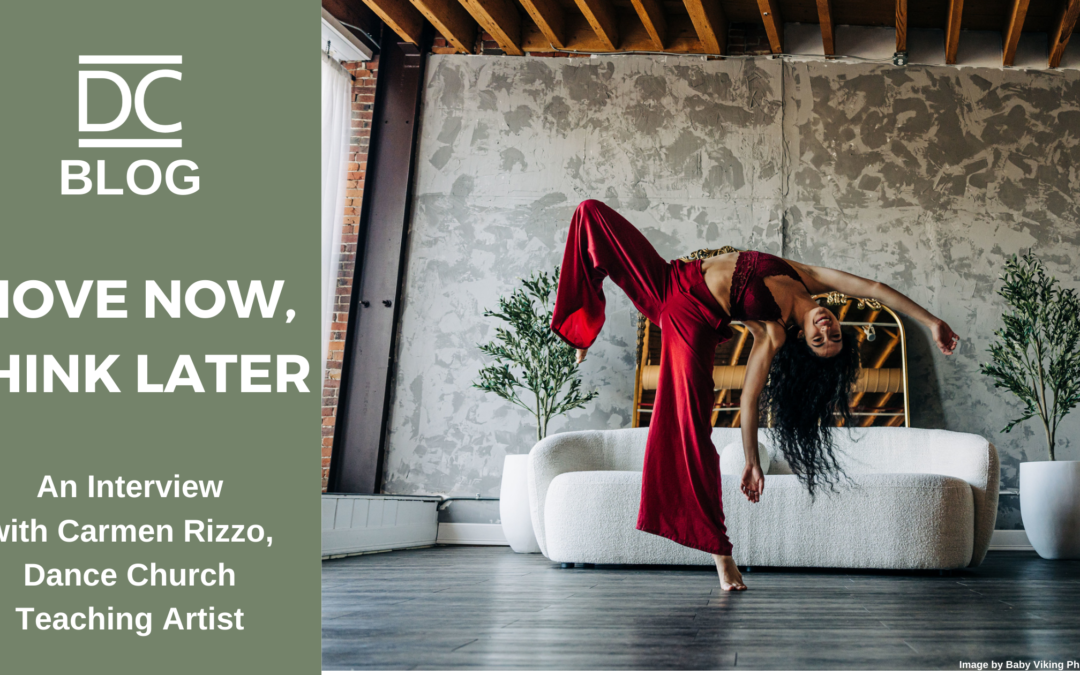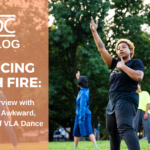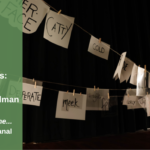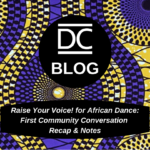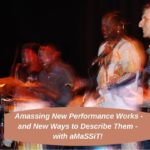Adorned in sweat atop the Studio 7 landing, I sat down with Carmen Rizzo as we caught our breaths after singing, stretching, moving, and dancing on a chilly Sunday morning. Carmen is a seasoned dancer, Dance Complex community ambassador, Operations and Membership Associate for Boston Dance Alliance, and Dance Church Teaching Artist. Throughout our conversation, she provides insight on the foundations and methodology of Dance Church, an all-levels movement class that offers a fun and inclusive approach to dancing and movement, founded on the West Coast in 2010 by dance artist Kate Wallich, and offered by Carmen weekly on Sunday mornings. Carmen continues to dream up the future of arts and dance in Boston and beyond, philosophizing dance and the brain along the way. Whether it’s the joyous camaraderie of Dance Church or the nuanced exploration of movement in various classes and settings, Carmen underscores the universal appeal of dance as a vehicle for self-expression, connection, and releasing inhibitions. Read on to learn more about Carmen and her role within The Dance Complex and Dance Church.
CJ Donohoe: That was awesome. That was so cool, and I really appreciate your facilitation. Could you just walk me through the thinking of a Dance Church class? It felt very methodical, yet the class flowed together really nicely.
Carmen Rizzo: Dance Church started in Seattle and it is now all over the United States. It really boomed during lockdown as everything moved online, everybody loved it and thought, this needs to come to my city. They started expanding when things started opening back up. One big thing for Dance Church is to have professional dancers teach instead of fitness instructors because they want to support the local dance community wherever they are. Teachers go through an application and interview process, and then a training process. In training, you learn the structure which is very improv based. We want to make sure to be mindful of people in the room and that they’re getting a complete workout. It’s not that you leave and are sore in just one part of your body… you’re sore everywhere. The idea is to have party vibes so you don’t notice that you’re working out. We don’t use mirrors – it’s not about being perfect or having the right form or looking a certain way, it’s about what you are feeling. There are moments when we’re focused on getting our heart rate up, other moments are focused on building muscle strength, but how all that is done is up to each teacher. During training, we were given some suggestions on how we could make the dance space organic and improv-based. It’s not just about “follow me”, it’s not a Zumba class. It’s not about doing it on your right or left side and doing it ‘right’, no one should care about that in this space. So, yes, there is a structure but every teacher is gonna lead differently, and honestly, every class is different too. Part of the structure is to pull inspiration from the people around you. I’m constantly looking around the room to see first, that everyone is being safe. Second, to watch people and notice how I can adapt what other people are doing to make it accessible for everyone. Once I start doing it, everyone else starts too as well. Louise is someone who comes regularly and she’s always doing something completely different. I love it so much because that is the point. Someone else came in one time and started doing yoga in the corner. There’s room for that here. And it allows other people in the space to think, ’Actually I don’t want to be jumping around, I want to do some yoga or stretch for a bit.’
Especially as people have begun to come regularly, it’s such a blessing to give them the space to do whatever they need. And it’s also a blessing to me and everyone else in the room because it’s giving everyone permission.
CD: How have you built the community of people that come regularly here? Who pops in and who comes regularly?
CR: There are a few people who come every week and many of them have known about Dance Church online and then when they realized it was coming to Boston in person, they knew they wanted to try it. Of course, the vibe in person is so much better and they just keep coming back. Online is fun too. It gives you that privacy, but also doesn’t give you inspiration to try something new and move around a big space with other people. Dance Church headquarters does a lot of publicity for classes, which I do as well through Instagram, friends, and organic word of mouth. I’ll put posters up too. It’s one of the few spaces where I genuinely feel like anyone is welcome and I see that when people come in. In today’s class, there were people above 60, and then there were people who were almost teenagers. A couple of weeks ago there was a guy who came in and asked me, how old are you? I said 25, he said he was 74, and he had the best energy. Dancing like crazy and having the best time. It’s a good reminder for both dancers and non-dancers of the pleasure of dance. In the professional world, we’re so consumed with delivering something. Here, you don’t have to deliver anything.
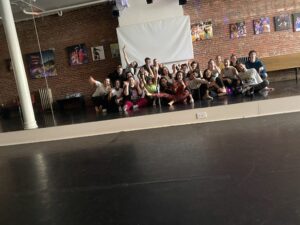
CD: How did you find yourself doing this class at The Dance Complex?
CR: The Dance Complex has a historical importance to the community and I am bringing people who are not all dancers to the space. Part of the mission of Dance Church is to support the local dance community in whichever city there are classes. I figured, what a great place to show people who aren’t typically in the dance circuit, and to introduce them to the many other dance engagements at The Dance Complex. Many people not in the dance world who live or work around here never knew about this place. The support that The Dance Complex provides is huge, it’s a way to say thank you.
CD: Zooming out, when did you first learn about The Dance Complex?
CR: I graduated college in New York, originally I planned to stay in New York, but the pandemic hit and plans changed. I’m originally from Brazil but I wanted to stay in the US. Specifically somewhere that was close to New York so I could maintain my connections, but still had dance happening. So Boston was the option. I got into a dance company in 2020 and I was in love with their work. It was during that time with the company where we had a couple of rehearsals here [at The Dance Complex] and I was like, what is this? I remember coming to the building and thinking, this place was magical. If you’re just walking by you can easily pass it but when you walk in, there’s so much dance happening here all the time, in all different styles. I just think it’s so magical.
CD: What are other ways you interacted with The Dance Complex in your other creative and artistic venues? Other ways of performing, class taking, seeing performances, becoming a teaching artist, and being a community ambassador?
CR: After leaving the company, I came even more to The Dance Complex because I had more time. While I was checking out all the different offerings, I learned about the community ambassador program, and I knew this was exactly what I needed. It was the perfect way to get involved in the community more and do something that I genuinely feel good about. I like helping The Dance Complex, even if it’s just opening the building or covering a shift. I know from working in many different organizations on many levels that those small things matter.
The magic I felt first walking into The Dance Complex was because of every single person involved. So getting to be any part of that is very fulfilling for me. It’s also a great opportunity to force myself to take more classes without money being a barrier.
CD: What have been some of your favorite classes that you have taken?
CR: Honestly, I’m not a commercial dancer at all, mostly concert-based and contemporary, but I love Patrick Planet’s class, he’s so fun. There are many classes with companies that I love taking. VLA classes are always awesome, The Click classes like barefoot ballet and contemporary. Marcus’s ballet classes are fun and challenging.
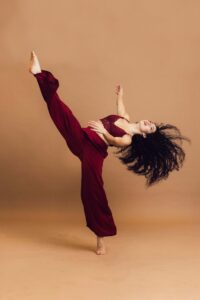
Image by Olivia Moon Photography
CD: How do you envision the future of dance and arts in Boston and what role do you see The Dance Complex and Dance Church playing in that future?
CR: On a bigger scale for the dance world as a whole, I hope dance and all other art forms talk more with each other, collaborate, inspire each other, and work together. I’ve noticed, especially after moving to the States, that everyone in the professional world is really talented, but only at one thing. There’s not a lot of dabbling in other forms. Not simply as a contemporary dancer taking ballet or hip-hop classes, but taking an art class, or ceramics class, writing poetry, and reading. These are small things that get your creative brain working.
Our brain is always working. It’s like when you can’t find something, and then two hours later you remember where it is. Your brain was working in the background that entire time. If we’re only focused on one thing, our brain isn’t able to branch out and expand to new possibilities and grow.
It’s part of being human, to dance and be an artist. While we spend so much time elevating and perfecting our own dance, your body can tell you what it needs. Start moving, and think later, no need to rationalize everything. Dance Church has a role in reminding people, those who have been dancing their whole lives and people who have never danced before, that this is what life is all about. We can talk about data that states how dance stimulates your brain and is good for your body but, simply put, no one has left this class feeling like shit. I believe that when people set out to be professional dancers, [Dance Church] is the feeling they are chasing.
The Dance Complex is already hosting a variety of classes, providing space for artists to grow and develop, and being in network with other artists. These are huge things that you don’t usually get from a rental space.
Those little elements are all catalysts for possibilities in the future. There’s a classtaker that comes a lot, James. I assumed he was a professional dancer and when I asked him, he said he was a business student. Outside of this, I would have never met him. But we joke around, that if people would just dance for 10 minutes a day, the world would be so much better.
Sometimes during a slow part of class when we’re lying on the floor, there’s some crying. I always check in and I’ve learned that when we dance, there’s a part of our brain, our inhibitions, that turn off and locked-up feelings can be released. Sometimes through laughing, or crying, but we are able to let whatever it is, flow. We don’t get to do that in the regular world.
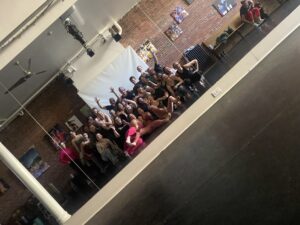
CD: I totally felt myself dropping in during class. For the first 20 minutes, I felt aware of everything that was happening around me, and then a wall just dropped, and I was in it.
CR: It’s a practice, the more you come, the wall will drop sooner. We don’t use a mirror because if we do, there’s an expectation to deliver something
CD: Anything you want to leave the people with?
CR: I’d like to say that I’m very open to people reaching out. I’m more than happy to chat with anyone who wants to chat. That’s also a part of community growth that I’ve found in Boston that was harder in New York. Dancers here are really willing to support each other. So reach out, email me, send me a pigeon, let’s chat.
Sign up for Carmen’s Dance Church classes, offered Sundays at 10 am, here.

